
中国国防部:境外间谍机关敌对势力渗透加剧
11/26/2021
中国国防部新闻局局长、国防部新闻发言人吴谦大校今天答记者问时说,当前,境外间谍机关和各种敌对势力对中国渗透窃密活动加剧。国家安全离人们并不遥远。每个人都是国家安全的一道防线。
根据中国国防部网站消息,有记者在今天举行的国防部例行记者会上提问称,某海洋公益组织近年来接受境外非政府组织资助,以“海洋垃圾监测”为名,在中国海岸线附近地区设立近百个监测点,近期被国家安全机关处置。请问对此有何评论?
吴谦说,当前,境外间谍机关和各种敌对势力对中国渗透窃密活动加剧,对国家安全,包括军事安全构成严重威胁。
他说,必须指出,国家安全离人们并不遥远,甚至就在身边。每个人都是国家安全的一道防线。希望大家加强国家安全意识,严守军事秘密。那些损害国家安全、泄露军事秘密的行为,必将受到法律的严惩。
中国官媒《环球时报》本月1日报道,从中国国家安全机关获悉,一家海洋公益组织近年来接受境外非政府组织资助,在大陆设立海洋垃圾监测点,搜集海洋监测数据等敏感数据并向境外提供。
虽未明确点名涉事组织,不过报道内一张涉事组织发布的研究报告封面照片显示,涉事组织为“上海仁渡海洋公益发展中心”。
根据该组织官网介绍,这是一家目前中国大陆唯一专注于海洋垃圾议题的公益机构,成立于2007年,2013年注册为民办非企业单位,广泛参与海内外的交流与合作。
解放军闽南海域抢滩登陆实战演练
10/10/2021
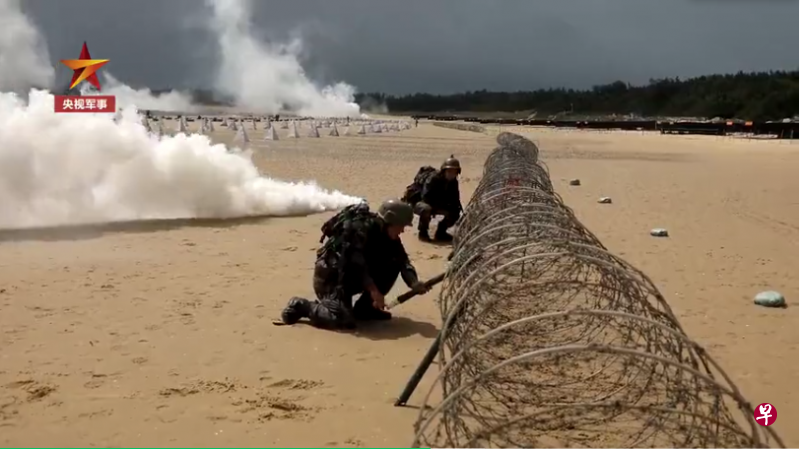
台海两岸情势持续紧张之际,中国大陆解放军陆军第73集团军某合成旅在闽南(福建南部)某海域组织进行抢滩登陆实战演练。
据中国央视军事昨天(10日)在官微发布第73集团军某合成旅抢滩登陆实战演练的视频,并称冲锋舟速度更快,可搭载人员更多,此次演练探索轻型舟艇远距离航渡登岸的作战模式,利用无人装备、激光交战系统,全方位锤炼部队抢滩登陆作战能力。
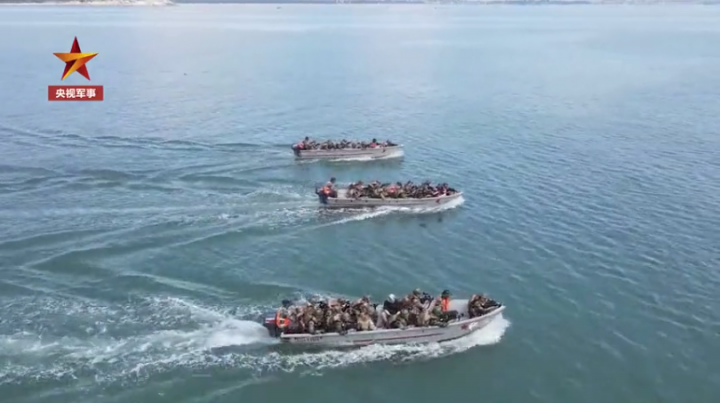
报道指,该旅将操舟手、突击手、爆破手等不同专业人员合理编组多支小队,分多波次抢滩,执行不同阶段作战任务。
视频显示,士兵们接到命令后迅速请领武器装备,分波次机动至目标地域。演练中,先遣组在烟雾手雷掩护下率先上岸,利用烟雾为后续小队指示安全登录位置。
视频指,现场融合多型无人装备,利用无人艇、无人机投放炸药,有效破除岸滩多种障碍。期间兵分多路,利用“奇袭爆破,包抄合围”等方式同时占领多处防御阵地。同时,火力分队迅速构设临时炮兵阵地,建立防御线,保障后续纵深攻击梯队加入战斗。

中国大陆近期不断加大对台军事施压,在今年国庆期间的五天内派出约150架次军机进入台湾西南防空识别区,舆论中“武统”声浪再度升温。
中共总书记习近平前天在辛亥革命110周年纪念大会上重申,以和平方式实现两岸统一最符合中华民族整体利益,展现较柔和姿态,但他也誓言一定要实现“祖国完全统一的历史任务”,并对台独发出严厉警告。
Oct 10, 2021
近日,陆军第73集团军某合成旅在闽南某海域进行了一场以实战为背景的抢滩登陆演练,演练围绕战备拉动、疏散隐蔽、机动集结、战术协同等多个课目展开,全面检验官兵渡海作战能力。 (国防军事早报·解放军新闻传播中心融媒体出品)
Oct 10, 2021
视频来源:新华每日电讯抖音号
Oct 9, 2021
近日,闽南某海域,陆军第73集团军某合成旅组织抢滩登陆实战演练,探索轻型舟艇远距离航渡登岸的作战模式。冲锋舟速度更快,可搭载人员更多。该旅将操舟手、突击手、爆破手等不同专业人员合理编组多支小队,分多波次抢滩,执行不同阶段作战任务。

北美法律公益讲座安排
时间:周二到周五 晚间
5:30-7:00(西部)
8:30-9:30(东部)
第二天西部时间早上9:00重播
周二: 如何准备遗嘱文件(遗嘱workshop)
周三: 数据泄露和个人身份保护&事业机会说明会
周四: 移民和留学生常见法律问题
周五:小企业企业常见法律问题&事业机会说明会
Zoom 6045004698,
密码:进群获取

解放军要核实驻台美军人数?
文 / 联合早报网综合整理
8/18/2021

美国共和党参议员科宁(John Cornyn)美东时间周一(16日)晚上在推特上声称,台湾驻有3万名美军。一石激起千层浪,中国大陆官媒《环球时报》迅猛回应,恫言若科宁所言属实,北京会“立即发动解放台湾战争”。
虽然相关推文随即在13个小时后被删除,但“解放台湾”等言论已在大陆舆论场熊熊燃起,不少大陆网民呼吁解放军“上岛核实一下(美军人数)”。科宁发文又撤文的动机也引起多方猜测。
引起轩然大波的推文
在阿富汗政局变天、美国总统拜登从阿撤军的行动受到千夫所指之际,科宁的推文列举了美国当今在世界各地的驻军人数,将之与此前在阿富汗的2500名驻军人数进行了对比。这位参议员辩称:“这些数字表明,我们以相对较少的部队接触实现了稳定,并且取得最近没有人员伤亡的良好记录。”
根据科宁的推文,美军在韩国有2万8000名、德国有3万5486名、日本有5万名、台湾有3万名、非洲有7000名,而在阿富汗有2500人。
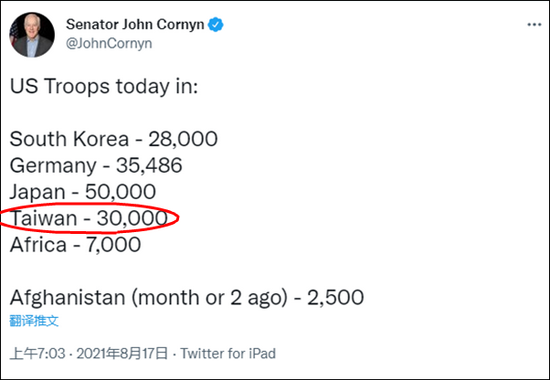
科宁似乎是想通过对比来突出近年在阿美军人数之少,但众人将目光投向了他列出的驻台美军人数上。
不少网民在推特上质疑科宁的数据:“这是个危险的错误。台湾没有3万美国驻军!台湾没有美军基地。”“我们在台湾有驻军?真是个新鲜消息。”
台湾在野的国民党推特账号当天也回复了科宁的推文:“台湾没有3万美国驻军!最后一个美国驻军离开,是在1979年5月3日。”
有网民指出,科宁提出的“3万美军驻台”可能是他从维基百科(Wikipedia)上摘取的旧信息。
据维基百科“美军协防台湾司令部”这一条目,该司令部于1955年4月至1979年4月在台湾有约3万名军人。
美国有线电视新闻网(CNN)指科宁的数据“完全不正确”。CNN引述美国国防部的数据指,截至6月30日,台湾有30名美军现役人员和15名为国防部工作的文职人员。
右翼的美国传统基金会(Heritage Foundation)2004年10月的一份报告则说,从1954年开始,美国在香港和台湾部署了数千名军人,在台美军人数从1954年的4174人,增至1958年的1万9000人峰值,然后稳定在4000至1万人之间,直到1977年。报告指美国军队于1973年开始撤出台湾,所有部队于1979年撤出。
科宁声称美军现今在台有3万人,显然是错误的。
科宁何许人也

今年69岁的科宁是来自德克萨斯州的美国联邦参议院共和党籍资深参议员,现任参议院情报委员会成员。他于2002年成为德克萨斯州联邦参议院议员,也曾在2007年到2011年期间出任共和党参议院全国委员会主席。
在弗吉尼亚大学法学院取得法学硕士后,科宁曾在1985年至1991年担任德克萨斯州第37区域法院法官,后被选为德州最高法院的陪审法官。1998年至2002年间,科宁担任德州总检察长。
据路透社报道,科宁一贯对支持加强美国与台湾的关系直言不讳。就在上个月,美国跨党派参议员提出的“台湾伙伴关系法案”受到科宁的支持。该法案旨在推动美国国民警卫队与台湾成立“伙伴计划”。
而早在2018年,科宁就与参议院军事委员会议员殷荷菲(James Inhofe)致函美国时任总统特朗普,要求特朗普政府允许出售F-35型战斗机给台湾。
中国大陆的反应
中国大陆官媒《环球时报》在科宁发布涉事推文当天(北京时间17日)就迅速发出“锐评”文章说:“美国在台湾驻军严重违反中美建交协议,以及中美之间所有政治文件,严重违背国际法,甚至也严重违背美国的国内法。这形同于对中国台湾省实施军事入侵和占领,这是对中华人民共和国的宣战行为。”

文章严正要求美国政府立即对科宁的推文做出解释,也要求台湾立即做出解释。
该报在另一篇报道中写道:“我们不能排除美国真的在台湾藏了3万驻军,然后被这个美国国会参议院情报委员会的资深政客说漏了的可能性”。文章意味深长地写道:“或许,我们应该派人去台湾好好查查这件事了。”
《环球时报》国际版当天在推特发文说:“(科宁的)推文可能是一个令人瞠目结舌的错误,或者是一个‘白痴’参议员的炒作,但这足以让人看到美国政客在台湾海峡的关键问题上是多么不负责任。”

《环球时报》总编胡锡进昨天也环球网微信号上发文,指如果台湾真的驻扎3万美军,中国政府和中国人民决不会接受,“我们相信国家会立刻动用《反分裂国家法》,以战争方式消灭、驱逐在台湾的美国军队,同时武力收复台湾。”
根据中国人大网,2005年3月14日在全国人民代表大会第三次会议通过的《反分裂国家法》第八条列明:“‘台独’分裂势力以任何名义、任何方式造成台湾从中国分裂出去的事实,或者发生将会导致台湾从中国分裂出去的重大事变,或者和平统一的可能性完全丧失,国家得采取非和平方式及其他必要措施,捍卫国家主权和领土完整。”
值得一提的是,中国大陆官媒曾多次称,美军入台之际,就是武统台湾之时。不过,美军军机今年6月6日、7月15日、7月19日曾三次在台湾降落,其中一次是搭载现役美国国会议员访台,还有两次任务并未对外公开说明,这都让大陆舆论沸腾。
中国国防部发言人吴谦7月15日曾警告称:“台湾是中国领土神圣不可分割的一部分。任何外军飞机降落我领土都必须经中华人民共和国政府许可,任何外国舰机擅闯我领空的行为,都将引发严重后果。”胡锡进7月20日则发微博称:“要说的话也都说了,接下来的就是行动了。”
科宁为何删文
科宁删推文,最直接的原因或是意识到自己的数据是错的。但延伸来看,北京的反应也是不得不考虑的。
台湾中时电子报今天一篇评论就指出,中国人民解放军东部战区昨天公布在台湾西南、东南等周边海空域进行军演,其中一个目的就是回应科宁的推文,“等于是间接警告美国政客,不要对台湾有妄想”。
中国大陆一名匿名学者昨天接受《环球时报》采访时则表示怀疑科宁发该推文是在故意滋事,可能想试探中方对美军在台驻扎这一信息的反应。若是这样,科宁达成目的后自然删了贴文。
无论如何,科宁删除的推文截图在互联网上疯传,覆水难收,近期本已高涨的“武统台湾”情绪在大陆社交媒体上更是沸腾。
不少网民说,删了也没用,解放军应上岛核实一下。
Update: Senator reveals ‘30,000 US troops stationed in Taiwan island,’ equal to ‘declaring war on China’ if it’s true;tweet deleted after wide controversy
By Liu Caiyu
8/18/2021
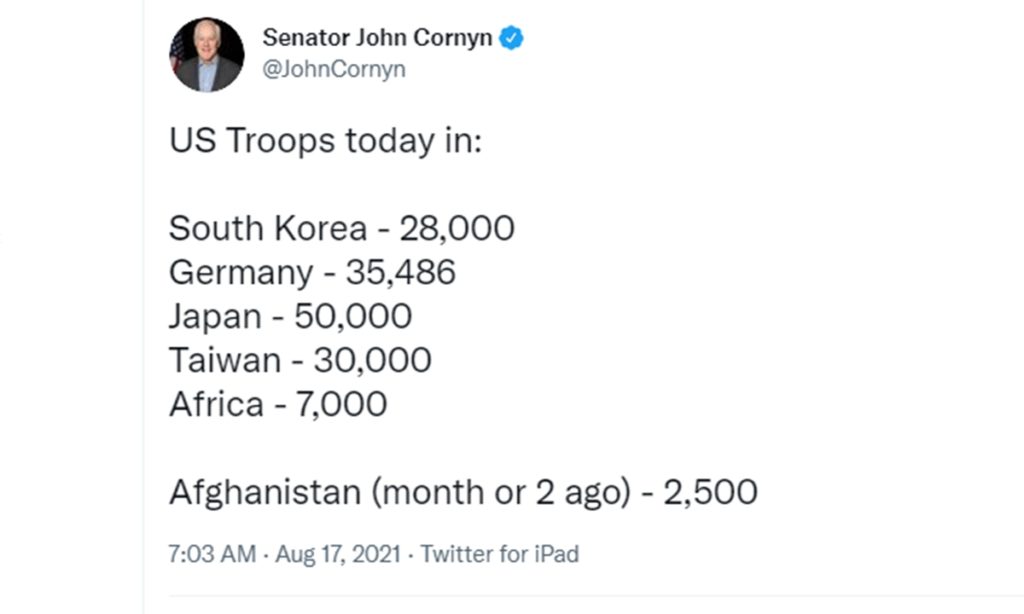
A senior US senator, also a member of US Senate Select Committee on Intelligence, on his social media revealed that the US has 30,000 soldiers stationed in China’s Taiwan island. If the tweet is correct, it is a military invasion and occupation of China’s Taiwan and equivalent to the US declaring war on China. China could immediately activate its Anti-Secession Law to destroy and expel US troops in Taiwan and reunify Taiwan militarily, some experts noted.
Some others believe the news leaked by the US senator cannot be true because 30,000 is not some small amount that the US Army could hide and not being noticed in the island, and the US has nothing to gain by stationing the US Army in the island. Sacrificing its own interests to satisfy Taiwan separatists also does not fit with US foreign policy, just like the US did in Afghanistan.
In the tweet, Senator John Cornyn listed the number of US troops stationed in South Korea, Germany, Japan, China’s Taiwan and on the African continent to show how the number of US soldiers has dwindled in Afghanistan. But in the process, Cornyn revealed the shocking news that there are 30,000 US troops in China’s Taiwan island.
His tweet raised a wave of doubts among netizens with many commenting below his tweet: “how come the US still has troops in Taiwan,” “so the US army has a secret division in Taiwan,” “Cornyn must have mistaken the number,” and “this should have been before 1979.”
Cornyn did not immediately delete his tweet or make any corrections after he posted it on early Tuesday. He deleted the tweet until later his tweet ignited wide controversy and media attention.
Neither the senator nor the US government made any comments over the tweet.
The Taiwan island “defense department” made a low-key denial on Tuesday, saying it is wrong and it would not comment on it, Taiwan-based media outlet SETN.com reported.
As a senior senator from Texas, who was once a Republican Senate Majority Whip for the 114th and 115th Congresses, and now a member of US Senate Select Committee on Intelligence, Cornyn should be aware of the US government’s military intelligence.
Li Haidong, a professor at the Institute of International Relations of the China Foreign Affairs University, told the Global Times on Tuesday that such ridiculous and shocking news is more likely the result from the old age of the senator that makes him a dotard or his confusion about the data with previous data in the 1970s or 1960s. But we have to acknowledge that there are also some US senators fabricating data to boost their political careers.
Whether it is a mistake or hype, we could see the US politician has a lack of political sensitivity and is irresponsible in making public remarks, which is jaw-dropping, Li said.
“I would choose not to believe this is the real case,” Song Zhongping, a Chinese military expert and TV commentator, told the Global Times on Tuesday. He said the US cannot conceal 30,000 soldiers plus their equipment in the island. US would not dare or take such risk to do so. But we cannot rule out the possibility that the US would dispatch such amount of troops when a military conflict breaks out in the Taiwan Straits.
If the US and China went to a war because US brazenly stationed troops in the island of Taiwan, whether 30,000 or 1,000, the price cannot be paid off for the US and the US clearly understands it. It is impossible for the US to be silly enough to sacrifice itself to satisfy Taiwan separatists, Li noted.
Foreign policies of the US clearly demonstrate that the US would rather sacrifice its allies to satisfy its own demands and interests, as it has never been the opposite, and the scenarios in Afghanistan, Vietnam, Iraq and Syria are the evidence, the expert explained.
Also the day happens to be August 17, the day marking the signing of the US-PRC Joint Communique (1982), which was achieved after contentious negotiations on the US arms sales to Taiwan, and acknowledged Taiwan is part of China.
Intentional or not, such information being released on this special day is loathing and leaves the public an impression that the US may have gone back on its words as the communique stated, or whether the US is trying to probe China’s reactions over it through a charade. The US government and the Taiwan authorities should clarify Cornyn’s tweet, Chinese experts urged.
China and the US established diplomatic relations in 1979 on the condition of the US ceasing official relations with the island and withdrawing all US military from the island. Secretly hiding 30,000 troops in Taiwan island would seriously violate the Sino-US diplomatic agreement, seriously violate international law, and even the domestic law of the US, a Chinese expert specializing on the Taiwan question told the Global Times on condition of anonymity.
If the US really secretly stations 30,000 soldiers in China’s Taiwan island, the US as an external force is interfering with China’s internal affairs which violates China’s Anti-Secession Law. This would touch off a military conflict between the two countries, Song said.
China firmly opposes any US military personnel involvement in Taiwan affairs, or US soldiers setting foot on the island or launching any kind of military cooperation with the army of Taiwan island, Song said.
Some observers said if this is true, it’s tantamount to a military invasion and occupation of China’s Taiwan, and an act of declaring war on China. If the US really has troops stationed in Taiwan – even if the number is small – it would be a serious matter that has broken the bottom line.
Those US troops must withdraw immediately and unconditionally, and the US government and Taiwan authorities must publicly apologize for this, observers noted.
傅立民文章:中美竞争最终将如何收场
5/12/2021
核心提示:文章指出,如果美国被中国和“世界其他国家的崛起”逼下台,那也是因为自满的美国人未能让一种曾经成功过的制度去适应解决政治和经济积弊,并为新突破奠定基础。中国和其他国家与此毫不相干。
参考消息网 5月11日报道 俄罗斯《全球政治中的俄罗斯》双月刊网站5月3日发表题为《中美对抗将如何收场》的文章,作者为美国布朗大学沃森国际与公共事务研究所客座研究员、美国前助理国防部长傅立民。全文摘编如下:
现在,美国在所有方向上开始与中国竞争,人们不清楚这种竞争将把我们带向何方。在我们开展深入探讨之前,应当先思考几个关键问题:中美的赌注有多大?双方在已开始的斗争中将动用哪些现有战术能力和未来战略能力?长期竞争会对双方造成何种可能的影响?这场斗争最终将如何收场?
中美各有核心利益诉求
那么,让我们把过去视为客观现实并努力专注于未来。
中国政治精英认为,有五样基本的东西值得一赌:
一是彻底打消欧洲和日本帝国主义肢解中国的企图,以及美国以冷战方式实施干涉并策动台湾独立的念头;
二是为弥补过去中国国家尊严所受屈辱而争取地位和尊严;
三是严格防范可能破坏中国稳定并损害中国利益和领土完整的行动以及外国军事干预的发生;
四是让中国顺利重返其在遭受欧洲帝国主义干涉前所占据的经济和技术高地;
五是在地区和全球事务中扮演符合中国体量及其日益增强的国力的角色。
美国的政治精英也在五个方面投下赌注:
一是让美国维持其在全球和地区的政治、军事、经济和金融领先位置;
二是保住美国作为印太等地区中小国家可靠军事保护国的所谓“声誉”;
三是维护美国在所谓“世界秩序”中的优越性;
四是通过降低对不受美国及其盟国控制的供应的依赖来获得经济安全;
五是实现再工业化、提高高收入岗位的就业率,并恢复国内平静的社会经济形势。
现在,中美两国间的力量平衡正在迅速变化,而且趋势对美国不利。今天的中国拥有比美国更广泛的国际联系。它已成为包括欧盟在内的世界上大多数经济体的最大贸易伙伴,在全球贸易和投资中的领先优势不断扩大。中国在全球科技创新中发挥的作用越来越大,而美国的阵地却越来越小。
盟友未必唯美马首是瞻
中国崛起首先带来的是经济而非军事方面的挑战。自冷战结束10年后至今,我们从未在中美关系中看到过类似今天的敌对状态。今天的中国军队有能力保卫自己的国家免遭任何外国攻击。
值得庆幸的是,中国依旧竭力通过谈判而非军事手段的方式解决台湾问题。而这样的谈判可以确保和平的延续。目前,中国的战略目标是提高美国向亚太地区投射力量的成本,但并不直接威胁美国。
拜登承认:为了有效与更加强大的中国开展协作,需要强化自己的立场并争取别国的帮助。为此,他在政府测试国会有关消除美国自身弱点的意愿并与盟友及伙伴进行磋商前,迟迟未出台有关对华政治经济和军事路线的决策。
但如果美国当局听从那些希望与中国对抗的人士的意见,那么它会意外地发现,并不是很多人赞成这么做。拜登可能面临复杂的政治选择:要么弱化对中国的敌意以争取第三国支持,要么坚持对抗立场而不惜疏远大多数欧洲和亚洲盟国。
现实情况是:欧洲人感受不到来自中国的所谓“军事威胁”,而东南亚和南亚国家认为台湾问题是中国人的内部事务并竭力置身事外。甚至像日本这种对台当局“地位”有着直接战略关切的国家也不想冒险介入冲突。
实力对比正向中国倾斜
中美实力不对称状况的转变可能让形势变得更复杂,过去长期为美国带来优势的经济、技术和军事力量对比现在正向有利于中国的方向发展。
在社会转型初期,迎来了基于科学的新产业浪潮。这些产业包括人工智能、量子计算机、云分析、数据库、安全区块链等等。中国向科研和教育设施及开发和应用这些技术的劳动力资源投入巨资。相反,美国目前则面临长期预算赤字,因为政治僵局和没完没了的战争让华盛顿背上沉重的财政负担。这种局面如不扭转,中国和其他国家将很快令美国失去一个世纪以来在科技和教育领域的全球主导地位。
即使美国克服当前政治机能失调和财政赤字,中国在科技、工程和数字领域的崛起也将对美国全球和地区主导权构成挑战。这是一个多方面的问题,美国在解决这个问题时,有时会弄巧成拙。比如,将北京排除在国际太空合作之外,结果,中国发展自己的航天能力。
今天,美国极力阻止中国在5G网络占据优势,反倒促使中国建立有竞争力的半导体产业。人类历史表明,任何技术突破迟早都会以这样或那样的方式被复制,而且成果只会比原先更好。
最大威胁并非来自对手
付出的大量战略努力扩大和升级了中美之间不可调和的矛盾。双方都认为对手是其崩溃的可能原因。然而,最大威胁实际上来自国内趋势和事件,而非外国势力的行动。中美的世界地位取决于它们在国际舞台上如何行事,而非对手的行动。
如果美国被中国和“世界其他国家的崛起”逼下台,那也是因为自满的美国人未能让一种曾经成功过的制度去适应解决政治和经济积弊,并为新突破奠定基础。
美国在全世界的声望下降和追随者减少,与美国的国内政治事件、战略失误、对盟国和伙伴的公然蔑视、虚伪专断的制裁、作为主要外交工具的胁迫和低效外交有关。中国和其他国家与此毫不相干。
现在,为了与中国竞争,美国在很多方面也在借鉴北京建立的制度。华盛顿呼吁实行工业化政策,大幅增加科研开支,以及设立基础设施投资的特别银行和基金等。
Sino-American Antagonism: How Does This End?
Remarks to the Confucius Institute, University of Idaho, Moscow, Idaho
Ambassador Chas W. Freeman, Jr. (USFS, Ret.)
Visiting Scholar, Watson Institute of International and Public Affairs, Brown University
By video link from Washington, D.C.
15 April 2021
Fifty-three years ago, as a young foreign service officer, I helped ensure that Taipei rather than Beijing continued to represent China in the United Nations Security Council and elsewhere internationally. Since then, I have seen relations between China and the United States evolve from mutual ostracism based on stereotypes that bore little resemblance to reality to varying degrees of cooperation and mutual understanding and back again. Now we’re once again off to the races in all sorts of struggles with China with nary a clue where any of them will take us.
It seems to me that before we get too far along this path, we ought to pause to think a bit about a few key questions. These have been strikingly absent from our policy debate. Specifically:
- What are the stakes for China and for the United States respectively?
- What current tactical and future strategic capabilities does each bring to the fight we’ve now begun?
- What are the likely consequences for each side of protracted struggle with the other?
- How are these struggles most likely to turn out?
So, in my remarks today, I’ll take the past as given and try to focus on the future.
The Chinese political elite appears to believe that five main things are stake:
- A final reversal of the carve-up of China by European and Japanese imperialism, warlordism, the Chinese Civil War, and America’s Cold War intervention to separate Taiwan from the rest of the country.
- Status and “face” (self-esteem fed by the deference of others) that offset past foreign insults to national dignity.
- Assured defense against foreign “regime change” operations or military interventions that could threaten the rule of the Chinese Communist Party, China’s return to wealth and power, or the consolidation of China’s claimed frontiers.
- China’s uninterrupted return to the high economic and technological status it enjoyed before its eclipse by European imperialism.
- A role in the management of the affairs of the Indo-Pacific region and the world commensurate with China’s size and burgeoning capabilities.
The American political elite also appears to believe that what’s at stake[1] is five things:
- U.S. retention of global and regional politico-military, economic, technological, and monetary primacy.
- America’s reputation as the reliable military protector of lesser states in the Indo-Pacific and elsewhere.
- American paramountcy in a world order guided by the liberal democratic norms professed by the European Enlightenment and the American Revolution
- Economic security through reduced dependence on supply chains not controlled by the United States or countries beholden to it.
- Reindustrialization, higher levels of well-paying employment, and the restoration of domestic socioeconomic tranquility.
The People’s Republic of China came into being seventy-two years ago. For over one-third of its existence, the United States has been actively committed to the overthrow of its “Communist” government. That appears once again to be a hope, if not an explicit objective, of U.S. policy.
China and the United States have never been evenly matched except in self-righteousness, unwillingness to admit error, and a tendency to scapegoat each other. But, in many respects, the balance between the two countries is now rapidly shifting against America. The world expects China to regain its historical position as one-third to two-fifths of the global economy. China already has an economy that produces about one-third of the world’s manufactures and that is – by any measure other than nominal exchange rates – larger than that of the United States. President Trump’s trade and technology wars convinced the Chinese that they had to reduce reliance on imported foreign technologies, develop their own autonomous capabilities, and become fully competitive with America.
China is now in some ways more connected internationally than the United States. It is the largest foreign trade partner of most of the world’s economies, including the world’s largest – the European Union (EU). Its preeminence in global trade and investment flows is growing. The 700,000 Chinese students now enrolled in degree programs abroad dwarf the less than 60,000 students from the United States doing the same American universities still attract over one million foreign students annually but nearly half a million international students now opt to study in China. China’s role in global science and technological innovation is growing, while America’s is slipping. Chinese have come to constitute over one-fourth of the world’s STEM workers. They lead the world in patent applications by an increasingly wide margin.
Only four percent of American schools offer classes in Mandarin, but (with increasing competence) all Chinese schools teach English – the global lingua franca – from the third grade. America’s xenophobic closure of Chinese government-sponsored “Confucius Institutes” promises to cripple even the current pathetic level of student exposure to the Chinese language in U.S. schools. Meanwhile, the increasingly unwelcoming atmosphere on U.S. campuses has reduced applications by Chinese and other foreign students to American universities, especially in the physical sciences and engineering.[2]
The challenges posed by the rise of China are clearly more economic than military, but China and the United States are now locked in a level of armed hostility not seen since the first decade of the Cold War. Back then, U.S. forces dedicated to “containing” the People’s Republic and championing the rival Chinese regime on Taiwan were incomparably more modern and powerful than the People’s Liberation Army (PLA). Chinese forces were arrayed to resist an anticipated American attack they knew they could not defeat. The U.S. Cold War policy of containment blocked China from effectively asserting ancient claims to islands in its near seas, while opening the way for other claimants to occupy them.
The Chinese military can now defend their country against any conceivable foreign attack. They also appear to be capable of taking Taiwan over American opposition – even if only at tremendous cost to themselves, Taiwan, and the United States. It is disquieting that Beijing now judges that intimidation is the only way to bring Taipei to the negotiating table. But it is reassuring that China still strives for cross-Strait accommodation rather than military conquest of Taiwan and its pacification. The U.S. forces deployed along China’s coasts are there to deter such a conquest. But their presence also has the effect of backing and bolstering Taiwan’s refusal to talk about – still less negotiate – a relationship with the rest of China that might meet the minimal requirements of Chinese nationalism and thereby perpetuate peace.
The danger is that, with the disappearance of any apparent path to a nonviolent resolution of the Taiwan issue, China could conclude that it has no alternative to the use of force. It would not be surprising for it to calculate that to hold America at bay, it must match U.S. threats to it with equivalent threats to the United States. This is, after all, the strategic logic that, during the Cold War, led the Soviet Union to match the missiles the United States had deployed to Turkey with its own in Cuba. No one should rule out the possibility that Sino-American relations are headed toward an eventual reprise of the 1962 Cuban missile crisis.
America has long been in China’s face. The way things are going, in the future, China may also be in America’s. In the meantime, the aim of Chinese strategy is to raise the costs of American trans-Pacific power projection against it, not to threaten the United States.
President Biden has recognized that to deal effectively with an increasingly formidable China, the United States must strengthen itself as well as enlist the help of other countries. He has therefore deferred immediate decisions about what politico-economic and military China policies he should adopt until his administration can test the willingness of Congress to redress American weaknesses and can consult with allies, partners, and friends abroad. But, if Washington listens to those it seeks to recruit as auxiliaries in its opposition to China, it will discover that few of them share the all-out animus against China to which so many Americans have become committed. President Biden may well find he faces a hard political choice between whether to moderate American hostility to China to garner third country support, or to stick with confrontational policies that separate the United States from most of its European and Asian allies.
The awkward reality is that Europeans do not feel militarily threatened by China. Southeast and South Asians see Taiwan as a fight among Chinese from which they should keep their distance. By contrast with Taiwanese, they fear intimidation, not conquest by China. Even those countries, like Japan, with a direct strategic interest in the status of Taiwan don’t want to risk being drawn into a fight over it.
The Taiwan issue is a legacy of the Chinese civil war and U.S. Cold War containment policies. America’s allies look to Washington to manage it without reigniting conflict between the island and the rising great power on the Chinese mainland. If the U.S. does end up in a war with China, America is likely to be on its own or almost so.
To further complicate matters, past asymmetries are in the process of reversing themselves as balances of economic, technological, and military power that long favored Washington shift in favor of Beijing. The Greeks invented the concept of a “Europe” distinct from what they called “Asia.”[3] Chinese connectivity programs (the “Belt and Road”) are recreating a single “Eurasia.” Many countries in that vast expanse see an increasingly wealthy and powerful China as an ineluctable part of their own future and prosperity. Some seem more worried about collateral damage from aggressive actions by the United States than about great Han chauvinism. Few find the injustices of contemporary Chinese authoritarianism attractive, but fewer still are inclined to bandwagon with the United States against China.
By 2050, China is predicted to have a GDP of $58 trillion – almost three times larger than America’s today and more than two-thirds greater than the then-projected U.S. GDP of $34 trillion. China’s rapidly aging population leaves it with no apparent alternative to Japanese-style domestic automation and the offshoring of labor-intensive work to places that still have fast-growing working-age populations, like Africa. China is investing heavily in robotics, medicine, synthetic biology, nanobot cells and other technologies that can enhance and extend the productive lives of the aged. It is also adjusting and expanding its social security and public health systems. The United States faces analogous challenges, aggravated by increasingly xenophobic immigration policies, acceptance of mediocrity in education, crumbling infrastructure, and the pyramiding of national debt to finance routine government operations as well as correctives to damage from past self-indulgence. Americans talk about these problems but have yet to address them.
A wave of new science-based industries is in the early stages of transforming human societies. Examples include artificial intelligence, quantum computing, cloud analytics, blockchain-protected databases, microelectronics, the internet of things, electric and autonomous vehicles, robotics, nanotechnology, genomics, biopharmaceuticals, 3D/4D and bio-printing, virtual and augmented reality, nuclear fusion, and the synergies among these and other emerging technologies.
China is making major investments in the scientific and educational infrastructure and workforce needed to lead the development and deployment of most of these technologies. By contrast, at present, the United States is in chronic fiscal deficit, immobilized by political gridlock, and mired in never-ending wars that divert funds needed for domestic rejuvenation to the Pentagon. America’s human and physical infrastructure is already in sad condition, and it is deteriorating. If these weaknesses are not corrected, China and others will soon eclipse the century-long U.S. preeminence in global science, technology, and education. Or, as President Biden put it, China “will eat our lunch” and “own the future.”
Even if the United States overcomes its current political dysfunction and fiscal malnutrition, the upsurge in Chinese science, technology, engineering, and mathematics capabilities promises to challenge America’s retention of global as well as regional primacy. The competition is not limited to the Asia-Pacific region. It is multifaceted, and, in attempting to deal with it, the United States has sometimes been too clever by half – for example, excluding Beijing from international cooperation in space. This has led to an increasingly robust set of indigenous Chinese space-based capabilities, many of which are of military relevance.
Similarly, the U.S. effort to head off Chinese dominance of 5-G communications is now spurring the creation of a globally competitive semiconductor industry in China. In the short term, the Chinese microelectronics manufacturing sector faces great difficulties. It is always easier to buy things than to learn to make them. But, in the longer term, China has the will, the talent, the wherewithal, and the market to succeed. Human history is full of proofs that, one way or another, sooner or later, every technological advance can and will be duplicated, often with results that surpass the original.
The PLA has copied American practice by harnessing commercial technological innovation to military purposes. Its 军民融合 or “military-civil fusion” program recognizes that market-driven research and development and university-led innovation frequently outpace in-house efforts by the military establishment. As the United States did before it, China is linking industry and academia more closely to its national defense. The pace at which China develops innovative military applications from civilian-developed technology now promises to accelerate.
In response to U.S. military dominance of its periphery, China has invested in anti-ship, anti-air, counter-satellite, electronic warfare, and other capabilities to defend against a possible American attack. Some Chinese weapons systems break new ground – among them terminally-guided ballistic missile systems to kill carriers, quantum communications devices, naval rail guns, and stealth-penetrating radar. In the event of armed conflict, the PLA can now effectively block U.S. access to China’s near seas, including Taiwan.
The PLA Navy has many more hulls than the United States, its ships are more modern, some of its weapons have greater range, and its home-based battlefield support is much closer to the potential war zone. Chinese industry’s surge and conversion capacities now vastly exceed those of the United States. In any future war with China, the U.S. armed forces cannot expect to enjoy the technological superiority, information dominance, peerless capacity to replenish losses, and security of bases and supply lines they have had in past wars.
The strategic effects of the broadening and escalating antagonism between the United States and China have already been considerable. Let me cite some examples.
- It is dividing the world into competing technological ecospheres that are beginning to produce incompatible equipment and software, a reduction in globally traded goods and services, and an accelerated decline in American dominance of high-tech industries.
- It is generating an active threat to the U.S. dollar’s seven-decade-long command of international trade settlement. Increased use of other currencies menaces both the efficacy of U.S. sanctions and the continued exemption of the American economy from balance of trade and payments constraints that affect other countries.
- It has distorted and possibly destroyed the global “rules-bound order” for trade, helping to proliferate sub-global, non-inclusive free trade areas and forcing the development of ad hoc rather than institutionalized multilateral trade dispute resolution mechanisms.
- It is hampering global cooperation on planetwide problems like pandemics, climate change, environmental degradation, and nuclear non-proliferation. (For a time, scapegoating of China served to divert attention from a pathetically ineffectual U.S. domestic response to the COVID-19 pandemic.)
- It is pushing China and Russia into a broadening entente (limited partnership for limited purposes). It may now be driving Iran into affiliation with this dyad.
- It has helped to replace diplomacy with offensive bluster, blame games, and bullying that lower respect for both China and America in other countries, while imposing painful collateral damage on nations like Canada and Australia.
- It has brought about an alarming rise in the danger of a war over Taiwan, while accelerating both conventional and nuclear arms races between China and the United States.
There is no sign that either side intends to change course. Nine-in-ten U.S. adults are now hostile or ill-disposed toward China. Chinese hostility to the United States has risen to comparable levels.
To be sure, popular views are both ill-informed and fickle. And at least as many things could go wrong as go right for both China and the United States. The January 6 assault on the U.S. Capitol is a reminder that scenarios that once seemed preposterous can yet occur. Both China and the United States face internal as well as external challenges. This is a moment of fragility in the life of both countries. Game-changing events are not impossible to imagine.
In the near term, for example:
- A reversal of progress in countering the global pandemic could bring about a collapse in the global economy and lead to widespread unemployment and political unrest in both China and the United States.
- The death of the Dalai Lama could destabilize Sino-Indian relations. Beijing might find itself at war with New Delhi, which lusts to reverse its 1962 humiliation by the PLA, and which is once again aggressively probing the de facto border between the two countries. A Chinese defeat in the Himalayas could catalyze a disruptive change in China’s leadership. A victory could lead to Chinese strategic ebullience as well as Indian abandonment of nonalignment in favor of entente with the United States.
- A war in the Middle East or a crisis in Korea could challenge America while offering China an apparent opportunity to strike at Taiwan with relative impunity.
- The emergence of less prudent leadership in Taipei could lead to decisions there that impel Beijing to invoke its 2005 anti-secession law and use force to recover Taiwan despite an expectation that the United States would intervene.
- Other events involving Taiwan, such as a return of U.S. forces and installations to the island or the revelation of yet another Taiwanese nuclear weapons program, could trigger a Chinese use of force.
- The division, disorder, demoralization, partisanship, political gridlock, and uncontrolled immigration now troubling the United States could force Washington to focus on restoring domestic social order at the expense of attention to foreign commitments.
- The death or incapacitation of the top leader in either China or the United States could lead to disputes over succession that weaken government authority and decision-making, distracting and inviting miscalculation by one or the other side.
Of course, none of these things may happen, but the fact that they are not unimaginable underscores the shakiness of current strategic realities.
In the somewhat longer term, still other developments could alter the course of the contest. For example:
- Chinese “wolf warrior” diplomacy and economic bullying may so thoroughly alienate other countries that, to the extent they can, they turn their backs on China and join the United States in opposing it.
- Beijing’s obsession with political control could – not for the first time in China’s long history – suffocate its private sector and stifle innovation.
- China’s semiconductor, artificial intelligence, and robotics companies will either succeed or fail in their drive to outperform their American, Taiwanese, and other competitors. If they succeed, their competitors’ industries could be hollowed out and China could dominate cyberspace and related domains. If they fail, China will fall behind.
- Aging in China and a reversion to xenophobic immigration policies in the United States could reduce working-age populations, damage productivity, slow growth, and increase the welfare burden in either or both societies, forcing reductions in “defense” outlays and generating pressure for mutual disengagement from military confrontation.
- Chinese and other experiments with digital currency trade settlement could dethrone the dollar from its post-World War II global hegemony, force the United States to bring its balance of payments and trade into equilibrium, lower U.S. living standards, and greatly reduce American international power.
- Beijing’s brutal efforts to assimilate minorities to Han culture may not only fail but alienate Muslim and other foreign partners, while remaining a cause célèbre in the West, and empowering a broad international effort to ostracize China.
- The cognitive dissonance between Washington and allied capitals about China and other issues could effectively gut America’s alliances, leaving the United States isolated in its hardline decoupling from China.
- Japan might go nuclear, altering the calculus of deterrence in Northeast Asia, and enabling it to declare strategic autonomy from the United States without forgoing American non-nuclear protection.
- The United States and the Russian Federation could replace their current mutual hostility with an entente directed at balancing and constraining Chinese power.
- Climate change could not only inundate major Chinese and American coastal cities (like Shanghai and New York) but also lead to natural disasters like crop failures, super storms, floods, forest fires, and the devastating displacement of populations, leaving little enthusiasm and fewer resources in either country for competition with the other.
- Conversely, disunity at home could lead demagogues in either China or the United States to rally patriotic support by pursuing aggressive policies abroad.
- A failure to reforge mechanisms for international cooperation on public health issues could allow new pandemics to overwhelm national capacities to resist them.
- The PLA Navy could match the U.S. Navy’s deployments along China’s coasts with its own deployments along America’s, deterring U.S. intervention in China’s near abroad while creating the preconditions for an agreement by which each side would pull some or all of its forces back to its own side of the Pacific.
Few or none of these game-changing developments may happen. But they reveal the stakes both sides and the world at large have in finding ways to wind down the adversarial antagonism that has now gripped Sino-American relations.
Each side has come to see the other as the possible cause of its downfall. But each is actually more menaced by trends and events in its homeland than by what any foreign power might do to it. The position of each in the world depends more on how it conducts itself internationally than on how the other does. In a world in which power and influence are unevenly distributed not just between the U.S. and China but also among lesser players in world affairs, neither China nor the United States can expect to exercise unchecked dominance at either the regional or global level. China will not displace America from international primacy, but neither will America be able to retain primacy.
If China falters, it will not be because the United States has opposed it but because Beijing has adopted self-corroding policies and practices that obviate the successes of “reform and opening,” alienate foreign partners, and impair further progress. Mao’s China was a failure in terms of returning China to wealth and power but laid the basis for Deng Xiaoping to set aside ideological rigidities and sponsor the eclectic adaptation of international best practices to Chinese circumstances. Changes in Beijing’s domestic policies, the entrepreneurial energy these released, and the foreign relationships they enabled explain the differences between China from 1949 to 1979 and China from 1979 forward. Policies can determine outcomes.
To develop, Beijing has declared, China needs a “peaceful international environment.” It is bordered by 14 countries, four of which are nuclear-armed and four of which harbor unresolved territorial disputes with it. Its civil war with recalcitrant forces on Taiwan has not concluded. Japan and the United States, two countries with which China has been at war in still-living memory, are unreconciled to its renewed wealth and power. These factors place China on the defensive and constrain any impulse on its part to project its power beyond its periphery. To practice market Leninism successfully, China needs friends.
Deportment helps determine friendships. “Friends” are either (1) the rare comrades you would yield your own life to save and whom you expect would do the same for you; (2) partners who will go out of their way to do you a favor as you would for them; (3) companions whose presence you enjoy but with whom you share no real commitment; (4) sycophants who want something from you and strive to ingratiate themselves with you to get it; and (5) parasites who seek cunningly to exploit their association with you for their own interests without regard to yours.
The Chinese people are widely admired abroad. But there is no enthusiasm for either global or regional leadership by China’s government. Others acknowledge its accomplishments, but few find it appealing. As the Chinese phrase puts it, 笑里藏刀—their smiles conceal daggers. Insincere attachments that rest on sycophancy or parasitism are flattering but do not embody respect and are neither reliable nor steadfast. They can conceal disdain, create liabilities, and invite perfidy.
If China continues to allow its security services and diplomats to browbeat foreigners and treat other countries in the arrogantly abrasive and bullying manner it has recently adopted, the only international relationships it will have will be hypocritical, scheming, and untrustworthy. Many abroad will fear China, but none will faithfully support it, few will follow it, and some will opt to oppose it. China will “lose face.” And, when “face” is at stake, China has a well-established record of irrational reactions that make it its own worst enemy.
Similarly, if the United States is eclipsed by China and “the rise of the rest,” it will be because Americans, mired in complacency, failed to adjust a once brilliantly successful system to address accumulated politico-economic problems and lay a basis for resumed advance. China can neither compel America to reform nor stop it from doing so. Americans alone can reaffirm their constitution, fix their broken politics, restore competence to their government, strengthen their society by reducing its economic and racial inequities, rejuvenate the competitiveness of their capitalism, abide by the norms of international conduct they seek to impose on others, respect international diversity and other countries’ sovereignty, and discard militarism in favor of diplomacy.
The ongoing slippage in U.S. prestige and followership internationally owes far more to self-disfiguring American domestic developments, strategic blunders, open contempt for allies and partners, sanctimoniously high-handed sanctioneering, offensively coercive foreign policies, and self-implemented diplomatic disarmament than it does to an imagined onslaught on the preexisting global order by China or others. The Punch and Judy show put on by senior American and Chinese diplomats at Anchorage played well back home in both countries. It did not inspire foreign confidence in the wisdom or capacity for empathy of either side.
China achieved much of its post-Mao developmental success by applying ideas learned from America. In many respects, in the name of competing with China, the United States is now turning to copying elements of the resulting Chinese system. Politicians in Washington are calling for industrial policies; major ramp-ups in spending on science and technology; the creation of specialized banks and funds dedicated to infrastructure investment; national security-derived protectionism, subsidies; and preferential licensing for key technologies and national champion companies; and what amounts to currency manipulation to produce a cheaper dollar.
The United States also appears to be progressively adopting aspects of Beijing’s intolerant and intrusive definitions of political correctness and “national security,” even if Washington still leaves internet censorship and the manipulation of public opinion to corporate oligopolies rather than imposing government controls. But there is no need to point this out to those attending this session of the Confucius Institute at the University of Idaho. Some of you have personally experienced the “cancel culture” built into the latest round of Sinophobia in the United States.
American populism’s strategic dementia now competes with Chinese exceptionalism’s imperious demeanor. To one degree or another, in both countries, groupthink has become the enemy of constructive engagement. Each side’s resentment of its alleged past or current victimization at the hands of the other adds bitterness to the equation. Only Beijing’s habitual risk aversion now averts a bloody U.S. rendezvous with Chinese nationalism in a war over Taiwan.
All things being equal, if there is no war over Taiwan or other game-changing event, current trends – American protectionism, decoupling from supply chains connected to China, and cognitive dissonance with allies and partners – seem more likely to continue than to halt. This suggests a future in which:
- China’s neighbors and the many dozens of countries participating in its Belt and Road Initiative draw steadily closer to Beijing economically and financially. Brave talk notwithstanding, the United States no longer has the open markets, financial resources, or engineering capabilities to counter this. Washington has shown no capacity to sustain the level of diplomatic engagement with the countries of the Indo-Pacific, Central Asia, East Africa, Russia, or EU members states needed to match Beijing. It is failing to do so even in Latin America. You can’t best something with nothing other than rhetoric and, for now, that’s effectively all the United States is offering.
- As the division of the global market into separate trade and technological ecospheres proceeds, China will take the global lead in a widening list of consequential new technologies. Its scientific and technological achievements will attract foreign investors and corporate collaborators regardless of their misgivings about China’s political system. Where markets remain open to them, Chinese companies – state-owned and private – will compete successfully for market share with American, European, Japanese, and Korean companies.
- The growth in Chinese power – combined with persistent concerns about erratic behavior by America’s wounded democracy – will cause major regional powers like India, Indonesia, and Japan to develop regional coalitions, defense industrial cooperation projects, and collaborative diplomacy designed to balance China — with or without the United States.
- As its naval and air power expand, China will consolidate its military dominance of its periphery. Americans will be forced to think twice about intervening to protect Taiwan from PLA coercion or controlling China’s near seas. Armed clashes with the Chinese Navy, Air Force, and Rocket Forces are conceivable. These could either undermine or stiffen American willingness to escalate hostilities with China.
- The domestic and foreign purchasers of U.S. government debt could conclude that it is backed by little more than “modern monetary theory” and cease to buy it. This alone would end the “exorbitant privilege” of the United States, deprive Washington of the ability to enforce unilateral sanctions, and make the American dominance of the Indo-Pacific economically unsustainable.
- Taiwan’s increasing military vulnerability and dependence on mainland Chinese markets for its continued prosperity could compel it to negotiate a relationship with the rest of China sufficient to appease the demands of Chinese nationalism.
China seems confident that some of these or similar scenarios will unfold in the decades to come. Its strategic confidence and resolve contrast with a lack of similar conviction in America, where short-term cluelessness, enforced by fiscal fecklessness, still rules the day. The challenges to American status and presuppositions from China are real. They will not be overcome with fantasy foreign policies based on unrealistic assessments of current and future circumstances.
A deeply imbedded faith in liberal democratic ideology led some Americans to theorize that, given enough exposure to the United States, Chinese political culture would inevitably evolve into a version of America’s. That this did not happen was not a failure of “engagement,” as American Sinophobes would have it. China’s retention of its own authoritarian political culture reflects its system’s delivery of results that more than satisfied the material needs of the Chinese people while restoring their pride in their nation. What’s happened in China may or may not disprove theories about the inevitability of political liberalization in middle-class societies. This deserves reflection. But so does the thesis that, without fundamental domestic reform, the United States can outcompete a China that is rising on its own terms, not America’s, in a world in which the United States no longer calls the shots.
The future of China will be made or unmade in China. The future of the United States will be made or unmade in America. Neither is foreordained.
[1] See, e.g., Senator Tom Cotton’s articulation of U.S. objectives vis-à-vis China: https://www.cotton.senate.gov/imo/media/doc/210216_1700_China%20Report_FINAL.pdf
[2] https://www.nationalacademies.org/ocga/testimonies/116-session-1/maintaining-us-leadership-in-science-and-technology
[3] https://chasfreeman.net/the-challenge-of-asia/
Source: https://chasfreeman.net/sino-american-antagonism-how-does-this-end/
China beating US by being more like America
Cultivating human capital will be essential if the US rather than China is to be the base of the next industrial revolution
By BRANDON J WEICHERT
4/25/2021
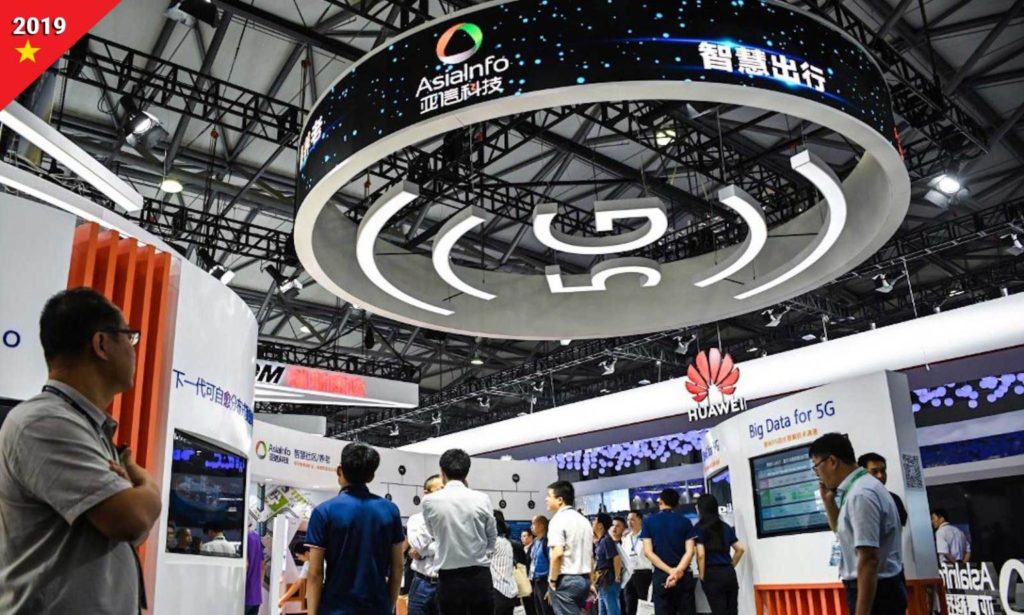
The United States transitioned from an agrarian backwater into an industrialized superstate in a rapid timeframe. One of the most decisive men in America’s industrialization was Samuel Slater.
As a young man, Slater worked in Britain’s advanced textile mills. He chafed under Britain’s rigid class system, believing he was being held back. So he moved to Rhode Island.
Once in America, Slater built the country’s first factory based entirely on that which he had learned from working in England’s textile mills – violating a British law that forbade its citizens from proliferating advanced British textile production to other countries.
Samuel Slater is still revered in the United States as the “Father of the American Factory System.” In Britain, if he is remembered at all, he is known by the epithet of “Slater the Traitor.”
After all, Samuel Slater engaged in what might today be referred to as “industrial espionage.” Without Slater, the United States would likely not have risen to become the industrial challenger to British imperial might that it did in the 19th century. Even if America had evolved to challenge British power without Slater’s help, it is likely the process would have taken longer than it actually did.
Many British leaders at the time likely dismissed Slater’s actions as little more than a nuisance. The Americans had not achieved anything unique. They were merely imitating their far more innovative cousins in Britain.
As the works of Oded Shenkar have proved, however, if given enough time, annoying imitators can become dynamic innovators. The British learned this lesson the hard way. America today appears intent on learning a similar hard truth … this time from China.
By the mid-20th century, the latent industrial power of the United States had been unleashed as the European empires, and eventually the British-led world order, collapsed under their own weight. America had built out its own industrial base and was waiting in the geopolitical wings to replace British power – which, of course, it did.
Few today think of Britain as anything more than a middle power in the US-dominated world order. This came about only because of the careful industrial and manipulative trade practices of American statesmen throughout the 19th and first half of the 20th century employed against British power.
The People’s Republic of China, like the United States of yesteryear with the British Empire, enjoys a strong trading relationship with the dominant power of the day. China has also free-ridden on the security guarantees of the dominant power, the United States.
The Americans are exhausting themselves while China grows stronger. Like the US in the previous century, inevitably, China will displace the dominant power through simple attrition in the non-military realm.
Many Americans reading this might be shocked to learn that China is not just the land of sweatshops and cheap knockoffs – any more than the United States of previous centuries was only the home of chattel slavery and King Cotton. China, like America, is a dynamic nation of economic activity and technological progress.
While the Chinese do imitate their innovative American competitors, China does this not because the country is incapable of innovating on its own. It’s just easier to imitate effective ideas produced by America, lowering China’s research and development costs. Plus, China’s industrial capacity allows the country to produce more goods than America – just as America had done to Britain
Once China quickly acquires advanced technology, capabilities, and capital from the West, Chinese firms then spin off those imitations and begin innovating. This is why China is challenging the West in quantum computing technology, biotech, space technologies, nanotechnology, 5G, artificial intelligence, and an assortment of other advanced technologies that constitute the Fourth Industrial Revolution.
Why reinvent the wheel when you can focus on making cheaper cars and better roads?
Since China opened itself up to the United States in the 1970s, American versions of Samuel Slater have flocked to China, taking with them the innovations, industries, and job offerings that would have gone to Americans had Washington never embraced Beijing.
America must simply make itself more attractive than China is to talent and capital. It must create a regulatory and tax system that is more competitive than China’s. Then Washington must seriously invest in federal R&D programs as well as dynamic infrastructure to support those programs.
As one chief executive of a Fortune 500 company told me in 2018, “If we don’t do business in China, our competitors will.”
Meanwhile, Americans must look at effective education as a national-security imperative. If we are living in a global, knowledge-based economy, then it stands to reason Americans will need greater knowledge to thrive. Therefore, cultivating human capital will be essential if America rather than China is to be the base of the next industrial revolution.
Besides, smart bombs are useless without smart people.
These are all things that the United States understood in centuries past. America bested the British Empire and replaced it as the world hegemon using these strategies. When the Soviet Union challenged America’s dominance, the US replicated the successful strategies it had used against Britain’s empire.
Self-reliance and individual innovativeness coupled with public- and private-sector cooperation catapulted the Americans ahead of their rivals. It’s why Samuel Slater fled to the nascent United States rather than staying in England.
America is losing the great competition for the 21st century because it has suffered historical amnesia. Its leaders, Democrats and Republicans alike, as well as its corporate tycoons and its people must recover the lost memory – before China cements its position as the world’s hegemon.
The greatest tragedy of all is that America has all of the tools it needs to succeed. All it needs to do is be more like it used to be in the past. To do that, competent and inspiring leadership is required. And that may prove to be the most destructive thing for America in the competition to win the 21st century.
Source: https://asiatimes.com/2021/04/china-beating-us-by-being-more-like-america/
Feb 18, 2021
Aug 4, 2020


